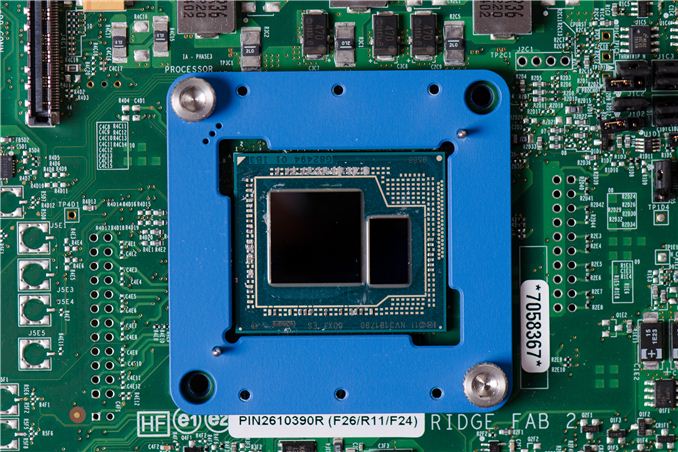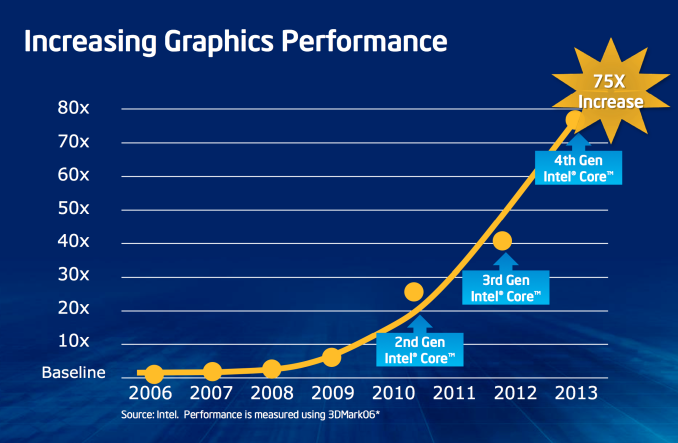Intel Iris Pro 5200 Graphics Review: Core i7-4950HQ Tested
by Anand Lal Shimpi on June 1, 2013 10:01 AM EST
The Prelude
As Intel got into the chipset business it quickly found itself faced with an interesting problem. As the number of supported IO interfaces increased (back then we were talking about things like AGP, FSB), the size of the North Bridge die had to increase in order to accommodate all of the external facing IO. Eventually Intel ended up in a situation where IO dictated a minimum die area for the chipset, but the actual controllers driving that IO didn’t need all of that die area. Intel effectively had some free space on its North Bridge die to do whatever it wanted with. In the late 90s Micron saw this problem and contemplating throwing some L3 cache onto its North Bridges. Intel’s solution was to give graphics away for free.
The budget for Intel graphics was always whatever free space remained once all other necessary controllers in the North Bridge were accounted for. As a result, Intel’s integrated graphics was never particularly good. Intel didn’t care about graphics, it just had some free space on a necessary piece of silicon and decided to do something with it. High performance GPUs need lots of transistors, something Intel would never give its graphics architects - they only got the bare minimum. It also didn’t make sense to focus on things like driver optimizations and image quality. Investing in people and infrastructure to support something you’re giving away for free never made a lot of sense.
Intel hired some very passionate graphics engineers, who always petitioned Intel management to give them more die area to work with, but the answer always came back no. Intel was a pure blooded CPU company, and the GPU industry wasn’t interesting enough at the time. Intel’s GPU leadership needed another approach.
A few years ago they got that break. Once again, it had to do with IO demands on chipset die area. Intel’s chipsets were always built on a n-1 or n-2 process. If Intel was building a 45nm CPU, the chipset would be built on 65nm or 90nm. This waterfall effect allowed Intel to help get more mileage out of its older fabs, which made the accountants at Intel quite happy as those $2 - $3B buildings are painfully useless once obsolete. As the PC industry grew, so did shipments of Intel chipsets. Each Intel CPU sold needed at least one other Intel chip built on a previous generation node. Interface widths as well as the number of IOs required on chipsets continued to increase, driving chipset die areas up once again. This time however, the problem wasn’t as easy to deal with as giving the graphics guys more die area to work with. Looking at demand for Intel chipsets, and the increasing die area, it became clear that one of two things had to happen: Intel would either have to build more fabs on older process nodes to keep up with demand, or Intel would have to integrate parts of the chipset into the CPU.
Not wanting to invest in older fab technology, Intel management green-lit the second option: to move the Graphics and Memory Controller Hub onto the CPU die. All that would remain off-die would be a lightweight IO controller for things like SATA and USB. PCIe, the memory controller, and graphics would all move onto the CPU package, and then eventually share the same die with the CPU cores.
Pure economics and an unwillingness to invest in older fabs made the GPU a first class citizen in Intel silicon terms, but Intel management still didn’t have the motivation to dedicate more die area to the GPU. That encouragement would come externally, from Apple.
Looking at the past few years of Apple products, you’ll recognize one common thread: Apple as a company values GPU performance. As a small customer of Intel’s, Apple’s GPU desires didn’t really matter, but as Apple grew, so did its influence within Intel. With every microprocessor generation, Intel talks to its major customers and uses their input to help shape the designs. There’s no sense in building silicon that no one wants to buy, so Intel engages its customers and rolls their feedback into silicon. Apple eventually got to the point where it was buying enough high-margin Intel silicon to influence Intel’s roadmap. That’s how we got Intel’s HD 3000. And that’s how we got here.











177 Comments
View All Comments
tipoo - Saturday, June 1, 2013 - link
It still seems to me that this misses where it would benefit most: 13 inch laptops, which currently mostly use dual core processors. GT3e would make something like the Retina MBP 13" much more appealing for instance, but it's paired with processors such that the wattage would be too high.tipoo - Saturday, June 1, 2013 - link
Oh and I wanted to ask, if the integrated graphics are disabled can the CPU still tap into the eDRAM?Ryan Smith - Saturday, June 1, 2013 - link
Yes, it's a dedicated cache for both the CPU and the GPU. However it's very unlikely you're going to run into any scenario that uses a Crystalwell-equipped part in such a manner. It's not being sold in socket form, so it will go to OEMs, who in turn would only use it if they didn't include a dGPU.jeffkibuule - Saturday, June 1, 2013 - link
So pretty much, unless you've got some huge beefy GPU that would absolutely suck up power compared to just using Iris Pro graphics, no one would opt for that SKU?shiznit - Saturday, June 1, 2013 - link
Right on. A dual core model for the 13" rMPB would have me selling my 2012 immediately. Now I need to decide if I can live with the 15" or even bother.moep - Saturday, June 1, 2013 - link
If i interpreted the results of this article correctly, I suspect that the 15" MBP is probably going to get a new and even thinner form factor with this refresh. (one chip less, fewer VRM related parts, lower combined TDP)A 15" rMBP approaching the weight of a 15" Macbook Air would be very interesting, although a part of me hoped that Apple would wait until Broadwell to ditch the dGPU in the 15".
Such a step back in GPU performance with the Retina display is surely not going to be very pleasant in 3D applications.
Galatian - Saturday, June 1, 2013 - link
I actually hope/suspect, that Apple will go the other road: use a discrete graphic solution on the 15" rMBP until Broadwell comes out, but have a cTDPdown version of the 4850HQ on the 13" rMBP. Maybe they can even get the normal TDP version in there; after all it has the same (good) cooling the 15" rMBP has and I have never heard the fans on mine. I think Apple really designed it with Haswell in mind, so let's see what they'll bring on during the next few weeks.tipoo - Saturday, June 1, 2013 - link
That's certainly the best case, I really hope they go down that road. The rMBP as a quad with Iris Pro would really make it worth the Pro name.vFunct - Sunday, June 2, 2013 - link
They'll probably stick with the built in GPU for the 13" model and a discrete GPU for the 15" model, which is what they do right now.Apple's top-end MacBook Pro has always had the highest end discrete GPU available.
Spunjji - Tuesday, June 4, 2013 - link
I'm guessing you mean "for a given power usage", as there are definitely faster GPUs out there than the 650M.